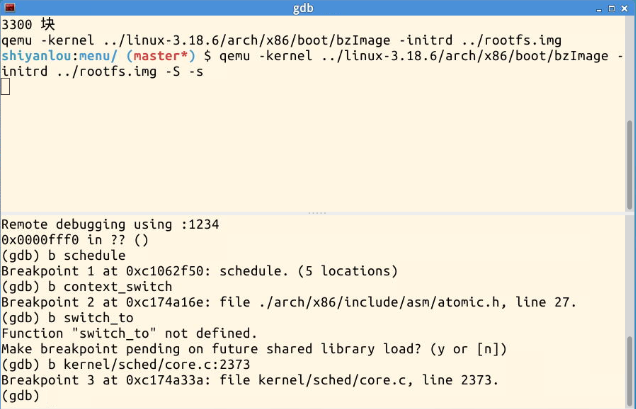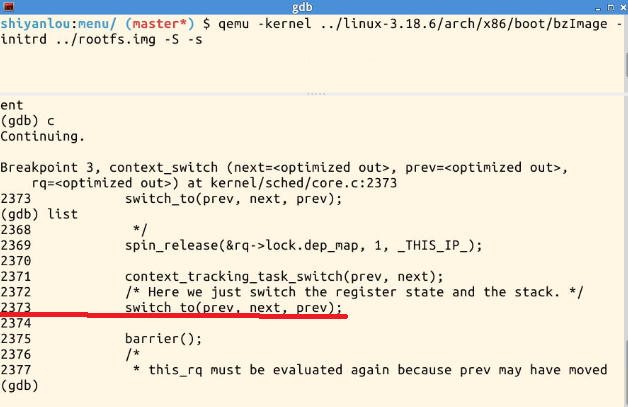2019-2020-1 20199313《Linux内核原理与分析》第九周作业
第九周学习——“进程的描述与进程的创建”
-
问题描述:
- 经过上一阶段的学习,我们逐渐了解了计算机操作系统的核心工作机制,构造了一个简单的Linux系统MenuOS,利用了GDB简单分析Start_kernel,我们还学习了使用系统的库函数,并在此基础上,学会了使用系统调用,使用gdb调试系统调用,并观察并观察fork函数是如何工作的函数是如何工作的,进一步学习了译链接的过程和ELF可执行文件格式。
-
本周学习:
- 本周在上周学习的基础上继续使用使用gdb调试系统调用,调试断点,分析系统调用运行过程。
- 对Linux内核装载和启动一个可执行程序
- 学习跟踪schedule,pick_next_task和context_switch等函数。
一、理论阐述
进程调度的时机
中断处理过程中,直接调用schedule()
内核线程可以直接调用schedule()进行进程切换
- schedule是一个内核函数,不是一个系统调用,进程的调度只发生在内核中,进程调度函数schedule()只能在内核中被调用,用户进程无法调用, 因此,进程切换需要用到实现用户态到内核态的切换。
- 中断处理过程直接调用schedule(),或者返回用户态时根据need_resched标记调用schedule()。内核线程是一个特殊的进程,只有内核态没有用户态,可以直接调用schedule()进行进程切换,也可以在中断处理过程中进行调度。
进程上下文切换
1、进程切换(或称任务切换、上下文切换):为了控制进程的执行,内核必须有能力挂起正在CPU上执行的进程,并恢复以前挂起的某个进程的执行。
2、挂起正在CPU上执行的进程,与中断时保存现场不同。中断前后是在同一个进程上下文中,只是由用户态转向内核态执行。进程上下文包含了进程执行需要的所有信息:
- 用户地址空间:包括程序代码,数据,用户堆栈等
- 控制信息:进程描述符,内核堆栈等
- 硬件上下文
二分析代码
- schedule的代码如下:
asmlinkage__visible void __sched schedule(void)
{
struct task_struct *tsk = current;
sched_submit_work(tsk);
__schedule();
}
static void __sched __schedule(void)
{
struct task_struct prev, next;
unsigned long switch_count;
struct rq rq;
int cpu;
need_resched:
preempt_disable();
cpu = smp_processor_id();
rq = cpu_rq(cpu);
rcu_note_context_switch(cpu);
prev = rq->curr;
schedule_debug(prev);
if (sched_feat(HRTICK))
hrtick_clear(rq);
/*
Make sure that signal_pending_state()->signal_pending() below
can't be reordered with __set_current_state(TASK_INTERRUPTIBLE)
done by the caller to avoid the race with signal_wake_up().
*/
smp_mb__before_spinlock();
raw_spin_lock_irq(&rq->lock);
switch_count = &prev->nivcsw;
if (prev->state && !(preempt_count() & PREEMPT_ACTIVE)) {
if (unlikely(signal_pending_state(prev->state, prev))) {
prev->state = TASK_RUNNING;
} else {
deactivate_task(rq, prev, DEQUEUE_SLEEP);
prev->on_rq = 0;
/*
If a worker went to sleep, notify and ask workqueue
whether it wants to wake up a task to maintain
concurrency.
*/
if (prev->flags & PF_WQ_WORKER) {
struct task_struct *to_wakeup;
to_wakeup = wq_worker_sleeping(prev, cpu);
if (to_wakeup)
try_to_wake_up_local(to_wakeup);
}
}
switch_count = &prev->nvcsw;
}
if (task_on_rq_queued(prev) || rq->skip_clock_update < 0)
update_rq_clock(rq);
next = pick_next_task(rq, prev);
clear_tsk_need_resched(prev);
clear_preempt_need_resched();
rq->skip_clock_update = 0;
if (likely(prev != next)) {
rq->nr_switches++;
rq->curr = next;
++*switch_count;
context_switch(rq, prev, next); /* unlocks the rq */
/*
* The context switch have flipped the stack from under us
* and restored the local variables which were saved when
* this task called schedule() in the past. prev == current
* is still correct, but it can be moved to another cpu/rq.
*/
cpu = smp_processor_id();
rq = cpu_rq(cpu);
} else
raw_spin_unlock_irq(&rq->lock);
post_schedule(rq);
sched_preempt_enable_no_resched();
if (need_resched())
goto need_resched;
}
next = pick_next_task(rq, prev),封装了进程调度算法,使用某种进程调度策略选择下一个进程。
之后用context_switch(rq, prev, next),实现进程上下文的切换。
然后switch_to(prev,next, prev),切换堆栈和寄存器的状态。
Linux运行的几种特殊情况:
①通过中断处理过程中的调度时机,用户态进程与内核线程之间互相切换和内核线程之间互相切换,与最一般的情况非常类似,只是内核线程运行过程中发生中断没有进程用户态和内核态的转换;
②内核线程主动调用schedule(),只有进程上下文的切换,没有发生中断上下文的切换,比最一般的情况略简略;
③创建子进程的系统调用在子进程中的执行起点及返回用户态,如fork一个子进程时;
④加载一个新的可执行程序后返回到用户态的情况,如execve系统调用加载新的可执行程序;
三、实验









